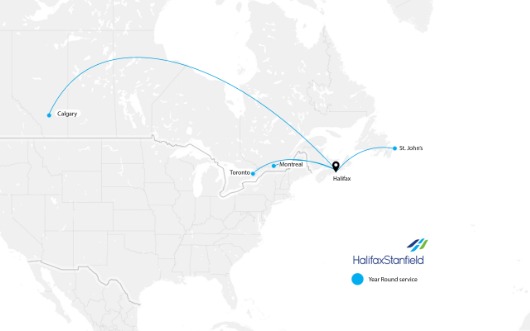
In 2020, Halifax Stanfield welcomed just 995,426 passengers. It’s the first time since 1972 the airport served fewer than one million passengers. Over two-thirds of those passengers travelled between January and March, before the pandemic took hold, resulting in federal and provincial travel restrictions that caused non-essential travel to come to a halt. From April to December, the airport saw a decline in passenger traffic of 91 per cent over the same period in 2019. Halifax Stanfield is currently connected to just four destinations, compared to the 46 that were planned for 2020.
“At the start of last year, Halifax Stanfield was well-positioned for growth, and our team was prepared for another successful year, having added two new international routes for our community members to enjoy,” said Joyce Carter, President and CEO, Halifax International Airport Authority (HIAA). “Little did we know, the COVID-19 pandemic would have an untold impact on our airport and its people, the aviation industry, and especially our communities.”
HIAA is joining Canada’s airports in asking the federal government to increase support to the air sector by collaborating on reasonable financial solutions and implementing a national, science-based approach to safely restarting air travel, such as airport testing and health screening. Restarting air travel is key in rebuilding Nova Scotia, and Atlantic Canada’s economies, through the tourism sector and beyond.
“The impact on regional air capacity as a result of COVID-19 has been devastating,” says Darlene Grant Fiander, President of the Tourism Industry Association of Nova Scotia (TIANS). “Recovery and rebuilding of our aviation sector will require focused financial and policy support so that Halifax Stanfield can continue its role as an economic powerhouse for both tourism and trade in the Atlantic region. A strong HIAA will ensure the resumption of the regional routes that have been discontinued during the pandemic.”
Halifax Stanfield plays an essential role in not only tourism, but also the broader economic impact of the entire Atlantic region. Pre-pandemic, the airport community supported 5,700 on-site jobs and contributed $3.8 billion annually to the Nova Scotia economy. As a result of COVID-19, it is expected that 50 per cent of Canadian aviation jobs will be lost, and even more could be affected in the tourism and hospitality sector.
“It’s been a very challenging year to operate at the airport,” said Lisa Olie, General Manager, Liquid Assets. “While this past year has been hard on us from a retail standpoint, the pandemic forced us to look at our business model in a new way. We now offer delivery service to supplement our much smaller revenue stream from airport activity. One of the most satisfying things we hear from airport customers who need to travel during the pandemic is that they’re glad we’re open for them. Being there for our customers in any manner they need us continues to be the reason we open up each day at Halifax Stanfield.”
